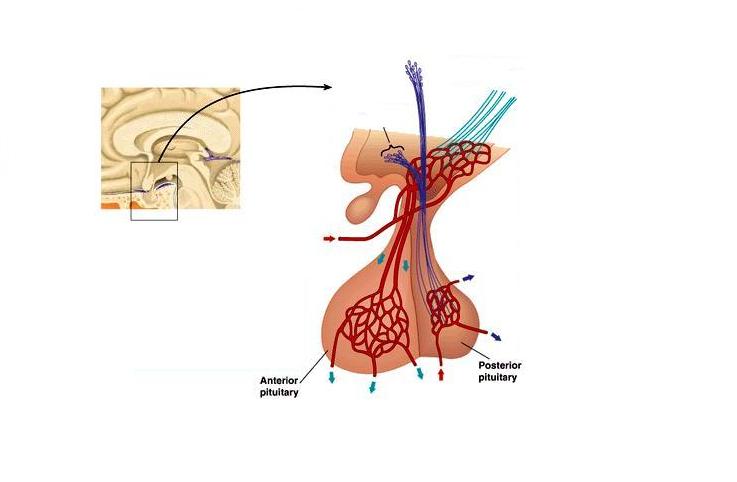|
The Endocrine System
Hormones are regulating chemicals that are produced by cells at one place in the body and affect cells in other parts of the body. Chemicals produced in glands and secreted directly into the blood are referred to as endocrine hormones.
The endocrine system provides integration and control of the organs and tissues. It is designed to maintain control over a long period of time. For example, growth and various sex hormones regulate and sustain development for years.
Chemical Signals: Steroid and Protein Hormones
|
|
Steroid Hormone
Ø The steroid hormone diffuses from the cell
Ø Hormone diffuses into the target cell and attaches to a receptor molecule
Ø The hormone-receptor complex moves into the nucleus and attaches to DNA
Ø A gene is activated in the DNA and initiates protein synthesis
|
|
Ø The protein hormone is released from the cell
Ø Hormone attaches to a receptor site on the outside of the cell membrane
Ø The hormone-receptor complex forms cyclic AMP from ATP
Ø Cyclic AMP acts as a messenger, activating enzymes in the cytoplasm to carry out their normal functions
| |
|
The Pituitary Gland
The pituitary gland is located at the base of the brain and it functions as a control centre, coordinating the endocrine and nervous systems with the hypothalamus. The pituitary gland produces and stores hormones, while the hypothalamus stimulates the release of hormones by the pituitary gland by way of nerves, and also produces hormones.
The pituitary gland is composed of two separate lobes: the posterior lobe and the anterior lobe.
vThe anterior lobe
- Produces its own hormones
- Hypothalamus regulates the release of hormones from the anterior pituitary

Hormones That Affect Blood Sugar
The pancreas contains cells that produce digestive enzymes and hormones. Within the pancreas there are thousands of structures called islets of Langerhans, which contain the cells that produce hormones. The islets consist of beta and alpha cells, which produce the hormones insulin and glucagon. Insulin is produced in the beta cells, while glucagon is produced in the alpha cells.
Insulin is released into the blood when the blood sugar is high (after a meal). The insulin causes the bodies cells to become permeable to the glucose. The liver converts glucose into glycogen. Thus, insulin enables the blood sugar level to return to normal.
Glucagon is released into the blood when the blood sugar levels are low (after fasting). It promotes the conversion of glycogen into glucose in the liver. This returns the blood sugar level back to normal.
Therefore, insulin causes a decrease in the blood sugar level, and glucagon causes an increase in the blood sugar level.
Diabetes - is a chronic disease that occurs when the body cannont produce any or enough insulin, or is unable to properly use the insulin it does make.
There are three main types of diabetes mellitus:
- Type 1 - the pancreas is unable to produce insulin because of early degeneration of beta cells in the islets of Langerhans.
- Type 2 - decreased insulin production or ineffective use of the insulin that body does produce
- Type 3 - gestational diabetes, a temporary condition that occurs in 2%-4% of pregnancies.
Hormones That Affect Metabolism
Thyroid Glands
- Regulates metabolic processes
- Located at the base of the neck, in front of the trachea
- There are two important thyroid hormones that regulate body metabolism: thyroxine (T4) and triiodothyronine (T3)
- Individuals who secrete high levels of thyroxine oxidize sugars and other nutrients at a faster rate; do not gain weight
- Individuals who secrete low levels of thyroxine do not oxidize sugars or other nutrients as quickly. Since the break down of sugars is slower, excess blood sugar is converted into glycogen until the liver and muscles are unable to store it, which then the excess sugar is converted into fat; muscle weakness, cold intolerance, dry skin and hair, and gain weight

- Thyroxine raises metabolism by stimulating an increase in sugar, which is used by body cells
- Higher levels of thyroxine stops the pathway
- Thyroxine inhibits the release of TRH from the hypothalamus, causing the production of TSH from the anterior pituitary to stop
Parathyroid Glands
- Regulates calcium levels in the blood and lower phosphate levels
- There are four small parathyroid glands located within the larger thyroid gland
- Low calcium levels in the blood stimulate the release of parathyroid hormone (PTH)
- A rise in PTH levels causes the calcium levels in the blood to increase and phosphate levels to decrease
Reproductive Hormones
The human reproductive system involves separate male and female reproductive systems.
Male Reproductive System
The male testes produce male sex cells called sperm. The hypothalamus and the pituitary gland in the brain control the production of sperm and male sex hormones in the testes. Negative feedback systems ensure that the number of sperm cells and constant levels of testosterone are maintained. The pituitary gland produces and stores the gonadotropic hormones, the follicle-stimulating hormone (FSH), and the luteinizing hormone (LH).
Female Reproductive System
The female ovaries produce eggs. The hypothalamus-pituitary complex regulates the production of estrogen and progesterone, the hormones of the ovary. The follicle-stimulating hormone (FSH) and luteinizing hormone (LH) regulate the control of estrogen and progesterone, which are produced by the ovaries.
|




